What Is Clean Claim Submission? 10 Reasons It’s Vital for Your Healthcare Practice

In the United States, the process of filing medical insurance claims is widely recognized for its complexity and susceptibility to errors, resulting in significant financial losses for healthcare providers amounting to billions of dollars annually. It is noteworthy that approximately 15% of all claims submitted to private insurers are initially rejected. In 2022, hospitals incurred an estimated $19.7 billion in expenses solely for the purpose of appealing and rectifying denied claims, representing a substantial financial burden. Moreover, industry statistics reveal that as much as 60% of claims that are returned are never resubmitted, resulting in lost revenue that practices cannot recover. This highlights the critical importance of clean claim submission. By guaranteeing that claims are submitted accurately (i.e., devoid of errors and fully complete) from the beginning, providers can improve their overall revenue cycle and prevent costly penalties and denials, and the appeal process associated with rejections. Indeed, submitting a clean claim on the first attempt is often recognized as the most effective strategy to boost payment rates and reduce the length of the revenue cycle. What constitutes a Clean Claim Submission? A clean claim denotes a health insurance claim that is fully complete and accurate at the time of its first submission. In essence, the claim is devoid of errors, missing information, or any issues that could delay payment. An official definition describes a clean claim as one that is submitted without any errors or complications (including absent documentation) that would hinder timely payment. This implies that all necessary data is present and precise. For instance, a clean claim accurately encompasses the patient’s information, the provider’s details, the service dates, the procedure codes, the diagnosis codes, and any requisite documents. The insurance company is able to process it without needing to return to the provider for corrections. Conversely, if a claim contains an error (such as an incorrect code or a missing patient birthdate), it is not considered clean; it may be rejected or denied until rectified. The objective of clean claim submission is to ensure that only clean claims are sent out. This process can be likened to submitting a flawless homework assignment that the teacher (insurer) readily accepts. Clean claims are essential as they “fuel your practice’s revenue and cash flow” due to their quicker approval times. Correct Provider and Facility Information: This specifies the provider (and facility, if relevant) along with all required identifiers (e.g., NPI). Accurate Patient and Insurance Details: It is essential that patient demographics and insurance policy details are thorough and validated (to ensure coverage eligibility). Proper Dates and Service Codes: The claim must contain the accurate date and location of service, as well as appropriately coded procedures (CPT, HCPCS, ICD-10), all of which should be included under the patient’s insurance plan. Medical Necessity & Documentation: The services provided must be deemed medically necessary and substantiated by relevant documentation (please attach notes, test results, and prior authorization references as needed). Compliance with Payer Rules: The claim is required to comply with all payer-specific regulations (such as correct modifiers, forms, etc.) and must be submitted within the designated timely filing period (for instance, within 90 days to 6 months of the service date, depending on the insurer). No Technical Errors: All mandatory fields should be filled out with the appropriate formatting, precise IDs or codes, and without any duplicate claims for the same service. This approach to clean claim submission enhances the process by avoiding unnecessary complications such as rejections or requests for additional information, extra documentation, or any other paperwork. By concentrating on every stage of the claim processing within a proficient medical billing system, ranging from patient intake and insurance verification to coding and final review, a healthcare practice can achieve a high rate of clean claims submissions. Now that we comprehend the significance of submitting clean claims, let us delve into ten essential reasons why clean claim submission in medical billing is crucial for the financial and operational well-being of your medical practice. 10 Reasons Why Submitting Clean Claims Is Essential for Your Practice Faster Reimbursements and Improved Cash Flow Employing clean claims in medical billing accelerates payment processing from insurers, thus improving the cash flow of your practice. When a claim includes the correct CPT and ICD-10 codes, the appropriate NPI, and successfully passes the clearinghouse EDI 837 scrub, it moves directly to the payer’s system. Their automated adjudication procedure can authorize it without superfluous exchanges or 277 correction notifications. Numerous states enforce prompt-pay regulations requiring insurers to issue an ERA and EFT within 30–45 days of receiving a clean claim, so ensuring accuracy from the outset guarantees timely cash flow. This consistent revenue covers daily expenses and allows for the acquisition of new laboratory equipment. Comparative Impact of Claim Quality on Revenue Velocity Revenue-Cycle Scenario Average Days-to-Payment Denial / Rework Rate Net Collection Rate Month-End Cash Position Streamlined “Express Lane” (Clean Claim Submission) 14 days 2% 98% of total charges USD 200,000 Delayed “Congested Lane” (Error-Prone Submissions) 45 days 12% 85% of total charges USD 140,000 The comparison illustrates that submitting clean claims is akin to maintaining revenue in an “express lane,” which guarantees predictable, swift, and optimized cash flow for the practice. Higher First-Pass Approval Rates (Fewer Denials) A significant advantage of utilizing clean claims medical billing is the substantial reduction in claim denials. Experts project that 85–90% of denials could be avoided if initial procedures, such as the verification of codes and patient details, are performed accurately. By addressing minor errors, such as omitted ICD-10 codes or erroneous modifiers, most claims can achieve a high approval rate on the first submission, leading to payment without the necessity for corrections. This greatly enhances your financial outcomes, as a claim that is resolved on the first attempt does not face the risk of remaining unpaid. Case Study The Spine & Wellness Center of America, a pain-management group consisting of nine physicians
How Does a General Surgery EHR Differ from a Generic EHR System?
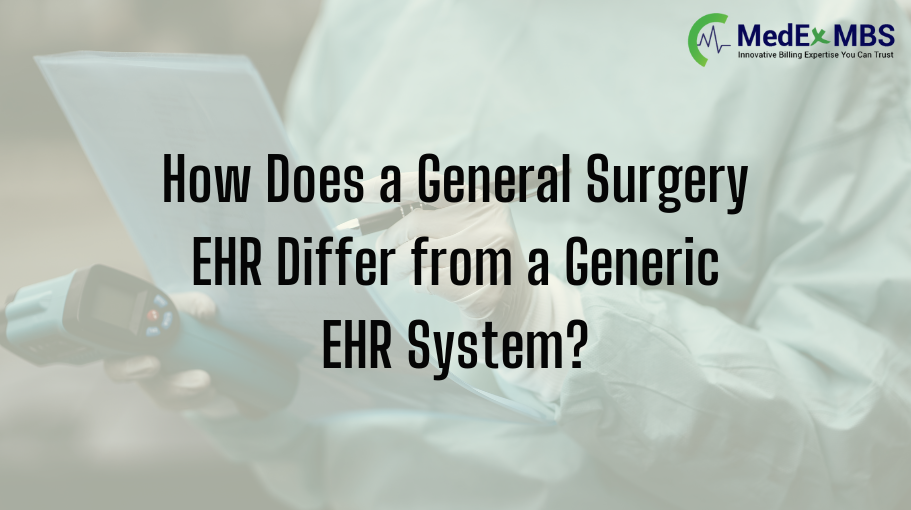
Currently, approximately 96% of hospitals in the United States utilize an Electronic Health Record (EHR) system; however, nearly half of surgical specialists continue to rely on generic systems. This leads to slower documentation processes, an increase in the number of clicks required, and the omission of crucial details essential for surgical care. Research indicates that transitioning from a generic EHR to a platform specifically designed for surgery can enhance documentation efficiency from 6.02 to 7.20 on a scale of 10. This transition results in more precise records, improved claim tracking, and enhanced workflow support. But what precisely distinguishes a general surgery EHR from a generic one? Why is this distinction significant for surgeons, patients, and hospitals? Let us begin with the fundamentals. What Distinguishes General Surgery EHR from Generic EHRs? Not all EHR systems are created equal. A general surgery EHR is specifically tailored for the workflows associated with surgical billing systems, whereas a generic EHR offers only broad, standard functionalities. A general surgery EHR encompasses templates for pre-operative and post-operative procedures, along with tools for creating operative notes. It also features surgical scheduling capabilities and coding tools specific to surgery. In contrast, a generic EHR provides basic functionalities such as charting, scheduling, and lab orders. However, surgeons frequently require customization, which can hinder efficiency and increase the likelihood of billing errors. Comparison of General Surgery EHR and Generic EHR General Surgery HER Generic EHR Templates for Pre-op, intra-op, and post-op Basic charting templates OR block scheduling and surgical calendars Standard patient scheduling CPT, ICD-10, and modifiers tailored for surgery General coding support Auto-populated operative notes Manual or limited note fields Tracks global periods and compliance Limited compliance features Reduces denials, maximizes revenue. Higher risk of errors and lost revenue What is a General Surgery EHR? A general surgery electronic health record (EHR) denotes a digital record system tailored specifically for surgical practices. It aligns with the workflow of surgeons, resulting in more precise documentation, easier compliance, and the ability for practices to secure full reimbursement. What is a Generic EHR? A Generic EHR is a flexible electronic health record system designed to serve multiple specialties. It provides fundamental EHR functionalities. While a generic EHR is effective for routine care, it typically lacks surgical templates and billing tools. Workflow in General Surgery EHR vs. Generic EHR General Surgery EHR Workflow An EHR tailored for the surgery streamlines the entire process. Pre-operative procedures begin with integrated templates. Operating room time is scheduled directly within the system, eliminating unnecessary back-and-forth communication. Subsequently, it applies the appropriate CPT codes and modifiers according to U.S. regulations to mitigate billing errors. Follow-up appointments are linked to the same episode of care, ensuring that nothing is overlooked. Generic EHR Workflow In contrast, a generic EHR requires more effort for every task. Pre-operative and post-operative notes must be created from scratch or extensively modified. Operating room scheduling occurs outside the system, leading to delays and miscommunication. Operative notes are entered manually, increasing the likelihood of omitting important details. Billing necessitates a review of codes and modifiers due to the absence of surgery-specific prompts. Additionally, follow-up appointments are monitored as standard office visits, resulting in compliance issues and slower reimbursement. Step in Workflow General Surgery EHR Generic EHR Pre-Op Prep Integrated surgical templates Custom notes created manually. OR Scheduling Direct operating room block scheduling Managed externally or with additional tools Operative Notes Auto-filled procedure fields Manual, labor-intensive entry Billing & Coding Surgery-specific CPT, modifiers, and global period tracking General coding: high risk of errors Post-Op & Follow-Up Bundled care is automatically tracked Handled as regular visits; risk of missed compliance. Differences Between General Surgery EHR Billing and Generic EHR General Surgery EHR Billing Specialty coding: Incorporates built-in CPT and ICD-10 codes specifically for surgical procedures. Modifier support: Automatically applies the appropriate surgical modifiers. Global period tracking: Monitors bundled pre-, intra-, and post-operative periods to prevent double-billing. Op note integration: Extracts billing codes directly from the operative note. Fewer denials: Surgery-specific validations minimize coding errors and denials. General surgery billing software leads to expedited claim submissions, cleaner claims, reduced denials, and enhanced reimbursement accuracy. Generic EHR Billing Basic Coding Support: Manages general CPT/ICD-10 codes but lacks the specificity required for surgical procedures. Limited Modifier Use: Modifiers often need to be manually added by coders or billers. No Global Period Tracking: Considers follow-up visits as separate appointments, which may lead to compliance issues and denials. Manual Data Entry: Operative details do not automatically link to billing; coders are required to manually extract the information. Higher Denial Rates: Increased errors and missed charges arise from the absence of specialty-specific checks. In comparison to general surgery medical billing software, generic billing necessitates more manual effort, results in higher denial rates, prolongs the revenue cycle, and increases the risk of underpayment for surgical practices. What are the Advantages and Disadvantages of General Surgery EHR and Generic EHR? General Surgery EHR Advantages Disadvantages Templates tailored to the specialty Higher expenses in comparison to general EHRs Management of OR block scheduling and surgical workflows May necessitate additional training for staff to utilize advanced functionalities Integrated surgical coding support (CPT, ICD-10, modifiers, global periods) Demands extensive staff training Enhances billing precision and decreases claim denials Excessive dependence on EHRs Boosts compliance with specialty-specific regulations The implementation process is prolonged. Generic EHR Advantages Disadvantages Lower initial costs compared to specialty EHRs Lacks templates and workflows specific
Understanding CPT Code 90832 for 30-Minute Psychotherapy Sessions in 2025
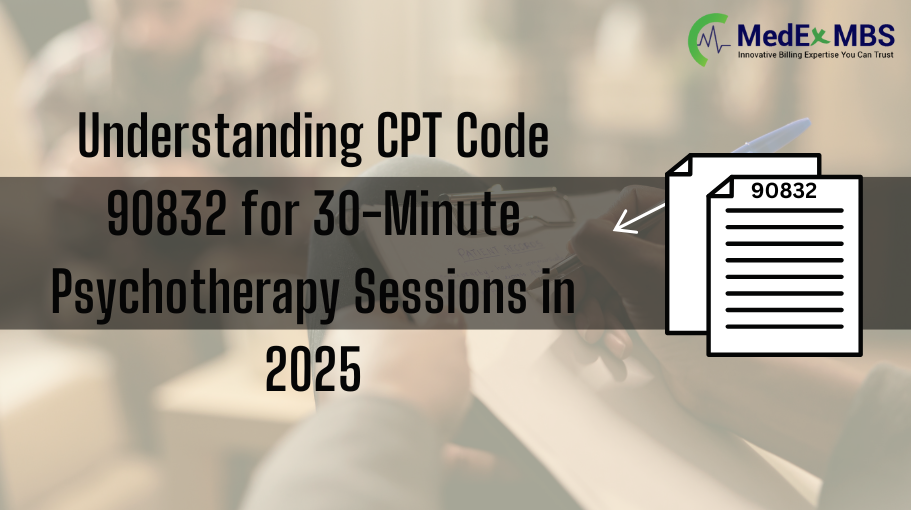
CPT Code 90832 serves as a specialized billing tool for mental health practitioners conducting brief therapeutic sessions. However, many providers are unsure about its correct application and its diminishing significance in contemporary practice. Although longer psychotherapy sessions are prevalent, it is crucial to comprehend when and how to utilize code 90832 for effective billing practices. This comprehensive guide provides mental health professionals with all necessary information regarding CPT Code 90832, including fundamental requirements and reimbursement rates for 2025, thereby facilitating accurate billing and maximizing revenue for 30-minute therapy sessions. Quick Facts CPT Code 90832 is designated for billing 30-minute individual psychotherapy sessions (16-37 minutes) In 2025, the reimbursement rate for 90832 under Medicare is set at $75.52 for each session. Only licensed mental health professionals are authorized to bill this code for individual therapy Sessions shorter than 16 minutes cannot be billed using CPT Code 90832 This code is increasingly infrequently utilized as providers favor longer session formats Accurate documentation and timing are critical for proper billing and reimbursement What is CPT Code 90832? CPT Code 90832, created by the American Medical Association (AMA) as part of the current procedural terminology system, pertains to individual psychotherapy sessions that last approximately 30 minutes. This specific psychotherapy code mandates that sessions last between 16-37 minutes of direct therapeutic interaction between licensed mental health providers and their patients. The code is categorized under mental health CPT codes and is one of several psychotherapy codes available for billing individual therapy services. Unlike other CPT codes utilized for psychiatric diagnostic assessments or medication management, 90832 is solely dedicated to therapeutic interventions conducted during focused sessions. Key Requirements for CPT Code 90832 Time Range: Sessions are required to have a duration of 16 to 37 minutes to qualify. Service Type: Individual psychotherapy only does not include group therapy, family therapy, or couples therapy Provider Requirements: Must be conducted by licensed mental health professionals Documentation: Demands detailed session notes that validate the medical services provided. Patient Present: All billable time must include direct interaction with the patient The CPT manual characterizes this code as significantly shorter than the more frequently utilized 90834 (38-52 minutes) or 90837 (53+ minutes), rendering it appropriate for particular clinical circumstances that necessitate shorter interventions. When to Use CPT Code 90832 Mental health providers should contemplate billing CPT code 90832 in various specific situations where shorter sessions correspond with clinical requirements and treatment strategies: Appropriate Use Cases Individual therapy sessions lasting 16-37 minutes with documented therapeutic content Routine outpatient psychotherapy appointments for patients who benefit from concentrated sessions Brief therapeutic interventions targeting specific symptoms or behavioral objectives Teletherapy sessions conducted through approved telehealth platforms within the designated time frame Follow-up sessions that do not necessitate the full extent of longer psychotherapy sessions Crisis intervention when brief, focused support is clinically suitable Clinical Scenarios Favoring Shorter Sessions Most providers observe that certain patient demographics respond more favorably to focused sessions. Children and adolescents frequently exhibit shorter attention spans, making 30-minute sessions more effective. Likewise, patients with anxiety disorders may initially manage shorter sessions more effectively before advancing to longer formats. Certain treatment plans explicitly require brief interventions, especially when addressing specific behavioral modifications or when offering supportive therapy during stable phases of care. When NOT to Utilize CPT Code 90832 Understanding the circumstances under which code 90832 should not be employed helps to avert billing mistakes and guarantees the correct selection of codes for various mental health services: Inappropriate Uses Sessions exceeding 37 minutes: Instead, utilize CPT 90834 (38-52 minutes) or 90837 (53+ minutes) Group therapy sessions: For group psychotherapy services, apply CPT 90853 Family or couples therapy: For family psychotherapy or family counseling, use CPT 90846 or 90847 Psychiatric evaluations: For diagnostic evaluation services, employ CPT 90791 or 90792 Medication management visits: Appropriate E/M codes should be used instead of psychotherapy codes Documentation Requirements for Exclusions Providers must document the actual time spent when sessions fall outside the 16-37 minute range to substantiate the correct code selection. Accurate time tracking is essential in the billing process to prevent claim denials and ensure adherence to coding guidelines. Reimbursement Considerations The reimbursement rates indicate that 90832 compensates approximately 75% of the rates for 90834 and 50% of the rates for 90837, reflecting the reduced time commitment. A majority of providers favor longer sessions utilizing 90834 or 90837 as they yield better revenue per session and facilitate more thorough therapeutic engagement. Session Timing Documentation Precise documentation of the start and end times of sessions is crucial for justifying code selection. The billing personnel must confirm that the time spent aligns with the appropriate range for each code to prevent billing inaccuracies. License Requirements and Billing Eligibility Only certain categories of licensed mental health professionals are authorized to bill CPT Code 90832, and the credentialing criteria differ based on payer and location: Eligible Provider Types Psychiatrists (MD/DO): Authorized to bill for all psychotherapy services Clinical psychologists (PhD/PsyD): Licensed to offer and bill for individual psychotherapy Licensed clinical social worker (LCSW): Eligible for independent billing practices Licensed professional counselors (LPC): Permitted to bill when appropriately credentialed Marriage and family therapists (MFT): Authorized for billing individual therapy Nurse practitioners (in certain states): May bill with the necessary mental health credentials Pre-Licensed Provider Considerations Pre-licensed mental health professionals are permitted to bill code 90832 under supervision, contingent upon specific documentation and modifiers. The supervising licensed provider must be credentialed with the insurance plan, and supervision requirements differ according to state regulations. Credentialing Requirements Prior to billing any CPT codes, providers are required to complete insurance credentialing with each payer. This encompasses Medicare provider enrollment for those attending to Medicare patients and distinct Medicaid enrollment for state programs. Add-On Codes and Combinations CPT 90832 can be used in conjunction with specific add-on codes when there is clinical
HIPAA-Compliant Billing Checklist 2025
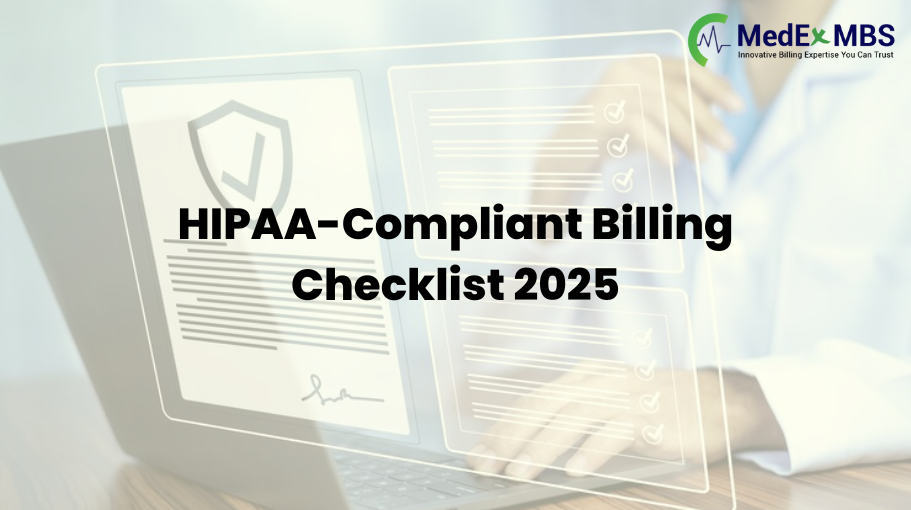
The complexity of HIPAA-compliant billing has increased significantly. In 2024, healthcare data breaches affected over 133 million records, and enforcement fines consistently exceeded $1 million for each violation. Healthcare organizations are encountering serious risks in this environment. The situation became even more complicated in 2025 when the Department of Health and Human Services (HHS) introduced the first significant update to the Security Rule since 2013. This update includes mandatory multi-factor authentication, encryption requirements, and much stricter oversight of vendors. For those managing a billing department, this means navigating evolving regulations while ensuring smooth operations and the protection of patient data. Regardless of whether you operate a small practice or a large healthcare provider, understanding these changes is crucial to avoid costly penalties and maintain patient trust. How Does HIPAA Influence Medical Billing? Let us begin with the fundamentals. It is essential to understand who is affected by HIPAA and how billing is integrated into these regulatory requirements. Who Must Comply with These Regulations Covered Entities: This includes healthcare providers, health plans, and clearinghouses that manage electronic health transactions. Business Associates: These are vendors and consultants who handle protected health information (PHI). The Three Primary Rules That Affect Billing Privacy Rule: Governs the usage, sharing, and disclosure of patient billing information. Breach Notification Rule: Outlines the procedures for reporting data breaches related to billing records and specifies the timing for such notifications. These regulations work in concert to ensure the security of patient data throughout the entire HIPAA-compliant billing process, from claim submission to payment processing. New HIPAA Compliance Obligations for 2025 The regulatory landscape has undergone significant changes this year. Significant Modifications to Security Regulations (January 2025) Mandatory Multi-Factor Authentication: Now a requirement for accessing the billing system Required Encryption: Both stored and in-transit data must be safeguarded Annual Penetration Testing: Yearly security assessments and biannual vulnerability scans are necessary 24-Hour Vendor Notifications: Business partners must inform you within a day if an issue arises Stricter Enforcement OCR investigations increased by 264% following the ransomware incidents of 2024 More severe penalties if patients experience delays in obtaining their billing records New 6-year mandate for retaining all compliance documentation These modifications have shifted the guidance from “you should probably do this” to “you absolutely must do this.” Proactively addressing these changes is essential to avoid penalties. 10-Point HIPAA-Compliant Billing Checklist for 2025 Conduct a Comprehensive Risk Assessment and Map Your Systems Begin with an exhaustive Security Risk Analysis that specifically targets your HIPAA-compliant billing systems. Document every piece of technology that interacts with electronic protected health information (ePHI) – including practice management systems, clearinghouses, vendor platforms, and more. Create a detailed map illustrating the flow of patient information throughout your billing process, from initial registration to the receipt of the final payment. It is advisable to update this map annually or whenever you introduce new billing software, alter your procedures, or engage new vendors. Your documentation should address the likelihood of various threats, the vulnerabilities identified, and the specific strategies you employed to mitigate each risk. Establish Multi-Factor Authentication (No Exceptions) The upcoming changes to the 2025 Security Rule make it abundantly clear: multi-factor authentication is no longer optional. Anyone accessing billing systems containing ePHI is required to implement it. Deploy it throughout the HIPAA-compliant billing infrastructure: Practice management systems Electronic health record platforms Clearinghouse portals Vendor billing applications Email systems that manage PHI Ensure that individuals are required to verify their identity through at least two methods (password plus phone or app verification). Your MFA system must integrate seamlessly with the existing workflows of your billing team – security measures should not hinder productivity. Encrypt All Data All ePHI within HIPAA-compliant billing must be encrypted, whether it resides on your servers or is transmitted between systems. This includes data stored on servers, laptops, mobile devices, and backup systems, as well as any information exchanged between systems, vendors, and clearinghouses. Verify that your billing software, practice management system, and third-party applications utilize robust encryption (AES-256 at a minimum). The 2025 regulations mandate encryption as a necessity, rather than a luxury. Regulate Access to Information (And Terminate It Promptly) Implement stringent controls so that your HIPAA-compliant billing team can only access the PHI necessary for their specific roles. Establish various user categories such as: Claims processors (limited to claim preparation and submission) Payment posters (focused on payment and adjustment tasks) Billing managers (granted full access along with audit capabilities) Crucially, you must have procedures in place to revoke access within one hour when an employee departs or changes positions. This swift termination of access is a significant aspect of the proposed 2025 updates and prevents unauthorized individuals from accessing sensitive billing information. Develop Your Emergency Response Strategy and Vendor Notification System Formulate a strategy specifically addressing HIPAA-compliant billing security issues, system breaches, ransomware incidents, and unauthorized access to PHI. Your strategy must delineate clear responsibilities, notification timelines, and recovery procedures. Revise every Business Associate Agreement to ensure that vendors are obligated to inform you within 24 hours if they activate their emergency protocols. Organize Your Security Assessments The proposed 2025 Security Rule mandates regular assessments that extend beyond basic risk evaluations. Ensure that a thorough penetration test of your HIPAA-compliant billing systems is conducted annually by certified security professionals. Additionally, perform vulnerability scans biannually to identify potential weaknesses within your network. Document all findings and the corrective actions taken. These records demonstrate your proactive management of security when regulators conduct inquiries. Monitor Everything and Conduct Regular Reviews Enable comprehensive logging across all HIPAA-compliant billing systems to monitor who accesses PHI, the timing of such access, and the actions taken. Your logs should include: Attempts to log in and access patterns Modifications to PHI and adjustments to claims Changes to system settings Unsuccessful access attempts and security notifications Review these logs monthly for any irregularities and perform formal compliance evaluations at least once a year. These assessments ought
Complete Guide to the First Health Network Payer ID for Healthcare Providers
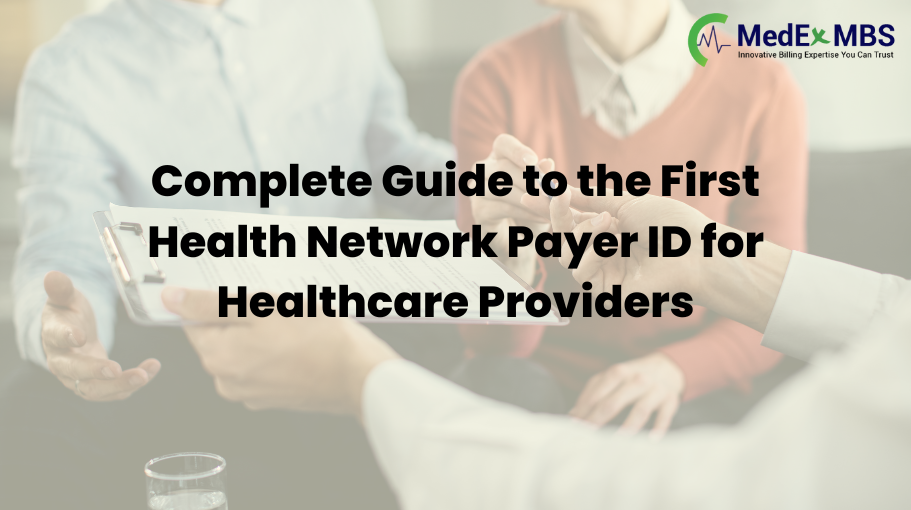
Electronic claims processing serves as the essential foundation of a healthcare practice’s revenue cycle. With over 4 billion healthcare claims processed annually in the United States, it is essential to use the correct payer ID to guarantee prompt payments. The FHNP ID acts as the key for providers to achieve efficient billing and minimize administrative burdens. Providers working in conjunction with First Health networks necessitate particular technical information to ensure that their claims are directed to the correct destination. This guide encompasses all necessary information, from the primary payer ID number to regional coverage differences, enabling medical billing professionals to confidently submit electronic claims. Key Points The network includes providers from First Health, First Choice of the Midwest, and Cofinity. Both Professional/1500 and Institutional/UB claims are accepted The network spans most US states with regional variations Overview The primary payer identification number for Health First Health Plans is 95019. Whether you are submitting Medicare claims or commercial insurance claims, this identification number ensures that your claims are sent to the appropriate processing center. The First Health network operates in accordance with HIPAA-compliant billing regulations and mandates the use of standard code sets, including ICD-10-CM for diagnoses and CPT/HCPCS for procedures. This compliance framework supports the processing of both primary and secondary claims, in addition to Electronic Remittance Advice (ERA). Technical Requirements All claims must adhere to the following requirements: Employ payer ID 95019 for Health First Health Plans Comply with HIPAA transaction standards Incorporate appropriate ICD, CPT, and HCPCS coding Follow AMA coding guidelines and Medicare policies Abide by Correct Coding Initiative (CCI) and Local Coverage Determinations (LCDs) The network also permits custom billing guidelines when standard rules are not applicable, particularly for complex medical situations, while still upholding compliance standards. Network Coverage and Provider Access The primary health network encompasses the majority of US territories, featuring regional differences that providers ought to be aware of. This network is composed of three essential elements: First Health, First Choice of the Midwest, and Cofinity providers. Geographic Coverage Breakdown Network Component Coverage Area Primary Focus First Health Most US states (with specific exclusions) Broad national coverage Cofinity Michigan State-specific network First Choice of the Midwest Idaho and Montana Regional Midwest coverage The secondary coverage encompasses the entirety of Alabama, specific counties in Florida, as well as other states that are not part of the primary network. This framework enables providers to utilize network resources regardless of their location. Provider Network Access This implies that patients with Curative coverage can consult First Health, First Choice of the Midwest, and Cofinity providers without any network limitations. This broadened access enhances patient choice and streamlines participation in the provider network. Claims Submission Requirements Healthcare providers must be aware of specific submission criteria to guarantee that claims are processed accurately. The network supports both Professional/1500 and Institutional/UB claims through the same payer ID system, thereby simplifying processes for multi-service providers. Professional Claims (1500 Forms) Professional claims necessitate: Payer ID 95019 in the appropriate field Provider NPI numbers CPT/HCPCS procedure codes ICD-10-CM diagnosis codes Patient demographic details Service date ranges Institutional Claims (UB Forms) Institutional submissions require: The same payer ID 95019 designation Revenue codes for facility services Bill type designations Principal and secondary diagnosis codes Discharge status when applicable Secondary Claims Processing The network facilitates the processing of secondary claims, allowing providers to submit claims when First Health acts as the secondary payer. This is particularly essential in situations involving Medicare supplements and the coordination of benefits. Providers must ensure that the primary payer information is thoroughly completed prior to submitting secondary claims to prevent any processing delays. Contact Information for Network Access Different inquiries related to the network necessitate distinct contact numbers to reach the appropriate support teams. Being aware of the correct number to call can significantly reduce hold times and enhance resolution efficiency. Special Benefits and Programs Curative members receive enhanced benefits that set the First Health Network apart from conventional insurance offerings. These programs are advantageous for both patients and providers. Member Benefits Structure Curative members enjoy: $0 deductible for in-network services $0 copay for covered services Enhanced prescription coverage Broadened access to provider networks Baseline Visit Requirements Benefits are activated after a Baseline Visit that occurs within 120 days of enrollment. This visit fulfills multiple purposes: Health Evaluation: A comprehensive assessment of the member’s health condition. Care Coordination: Establishing primary care relationships Benefit Activation: Initiating enhanced coverage options Prescription Access: Allowing access to preferred prescription coverage Providers are encouraged to arrange these visits for new Curative members to ensure they receive full access to benefits. The baseline visit also opens avenues for discussions on preventive care and health education. Employer Group Services The network is involved in employer group services, offering added value through partnership arrangements. These services typically encompass: Custom benefit designs Integration of wellness programs Resources for employee health education Specialized provider networks Comprehending these programs enables providers to better assist members of employer-sponsored plans and can lead to increased patient volume through group contracts. Frequently Asked Questions (FAQ) Q1. What is the FH ID? The payer identification number for Health First Health Plans is 95019. This should be used for all submissions of electronic claims. Q2. Which states are included in the First Health Network coverage? The network encompasses the majority of states in the United States, with specific exceptions such as Confinity in Michigan and First Choice of the Midwest in Idaho and Montana. Q3. What types of claims are eligible for submission? Claims can be submitted in both Professional/1500 and Institutional/UB formats. Secondary claims and ERA processing are also supported. Q4. Are secondary claims accepted? Yes, both secondary claims and ERA are accepted. Q5. What is the process for verifying patient eligibility? You can verify patient eligibility using the standard method with payer ID 95019, or you may call the network phone number for manual verification if electronic systems are unavailable. Providers who effectively utilize the FHNP ID system can enhance their revenue
What does the diagnosis code E11.42 represent for Type 2 Diabetes Mellitus?
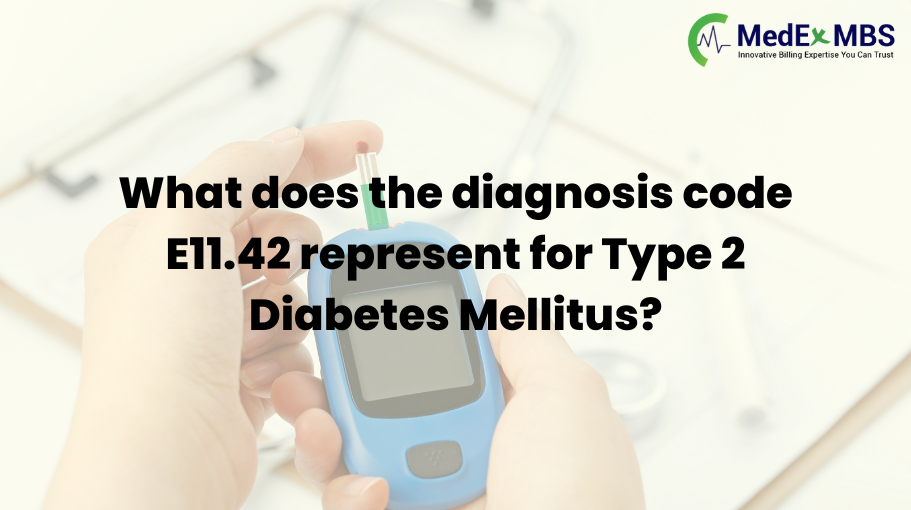
The E11.42 code relates to type 2 diabetes mellitus that is associated with diabetic polyneuropathy as defined in the ICD-10 classification. What you will learn here: The E11.42 code specifically designates type 2 diabetes mellitus accompanied by diabetic polyneuropathy, thereby guaranteeing accuracy in both treatment and documentation. Symptoms associated with diabetic polyneuropathy encompass numbness and pain in the extremities, necessitating diagnostic procedures such as nerve conduction velocity tests. Managing the E11.42 code requires a comprehensive approach that includes medication, lifestyle modifications, and possibly insulin to achieve optimal patient outcomes. What is the E11.42 Code? The E11.42 code is a component of the ICD-10 classification system, utilized to identify type 2 diabetes mellitus with diabetic polyneuropathy. This condition signifies nerve damage resulting from diabetes, which can manifest in various symptoms. The E11.42 code serves not merely as an identifier but as a designation for a specific condition that demands targeted treatment and management. By accurately identifying this complication within the broader context of diabetes-related issues, the E11.42 code guarantees that patients receive appropriate care. It also facilitates precise documentation, which is vital for treatment planning and insurance reimbursement. Definition and Classification The E11.42 code is categorized within the ICD-10-CM classification system, a global standard for diagnosing and coding diseases and conditions. More specifically, it falls under the E08-E13 category, which encompasses various forms of diabetes mellitus. Understanding this classification system is essential for recognizing the type of diabetes mellitus and its associated complications, particularly diabetic polyneuropathy. In the ICD-10-CM, the E11.42 code is classified under endocrine, nutritional, and metabolic diseases, making it pertinent to metabolic disorders. This specific classification of diseases ensures that healthcare providers can accurately diagnose and treat patients, highlighting the importance of maintaining clear and detailed medical records. The Significance of Documentation Accurate documentation is essential for effective healthcare. The identification of type 2 diabetes mellitus accompanied by diabetic polyneuropathy requires a blend of physical assessments and specific diagnostic tests. Inadequate or erroneous documentation may result in improper billing, mismanagement of treatment strategies, and denial of claims. The E11.42 code must be applied with a high degree of specificity to the patient’s condition. This entails a clear definition of terms such as ‘uncontrolled’ diabetes and the establishment of the connection between diabetes and its complications. Such meticulous documentation guarantees that patients receive appropriate care and that providers can substantiate the medical necessity of treatments for insurance purposes. Symptoms and Diagnosis of Type 2 Diabetes Mellitus with Diabetic Polyneuropathy Type 2 diabetes mellitus with diabetic polyneuropathy is a condition characterized by various symptoms that significantly impact patients’ daily lives. Understanding these symptoms and the diagnostic processes is vital for effective management. Common Symptoms The prevalent symptoms of type 2 diabetes mellitus with diabetic polyneuropathy include numbness, tingling, and pain in the extremities. These symptoms arise from nerve damage and can greatly hinder a patient’s capacity to perform daily activities. Diabetic autonomic neuropathy may lead to gastrointestinal issues, bladder dysfunction, and cardiovascular irregularities. In severe instances, these symptoms can escalate to exercise intolerance, resting tachycardia, and other complications affecting multiple organ systems. Early recognition of these symptoms can facilitate timely intervention and management, thereby enhancing patients’ quality of life. Diagnostic Procedures The identification of type 2 diabetes mellitus accompanied by diabetic polyneuropathy requires a blend of physical assessments and specific diagnostic tests. Physical examinations include reflex tests aimed at assessing neurological function and identifying any abnormalities. One of the primary diagnostic tools is the assessment of nerve conduction velocity, which evaluates the speed and strength of signals transmitted through the nerves. These assessments are crucial for determining the degree of nerve damage and for accurately confirming the presence of diabetic polyneuropathy, thereby facilitating precise coding with E11.42. Treatment Options for Patients with E11.42 Code Managing type 2 diabetes mellitus accompanied by diabetic polyneuropathy necessitates a comprehensive approach. Treatment alternatives encompass medications, lifestyle modifications, and advanced therapies, all of which play a significant role in alleviating symptoms and enhancing patient outcomes. Medications typically serve as the initial line of defense against the pain and discomfort associated with diabetic polyneuropathy. Pregabalin and duloxetine are the only FDA-approved medications specifically for painful diabetic polyneuropathy. These drugs, along with alternatives such as gabapentin and amitriptyline, are effective in managing neuropathic pain. Antidepressants like duloxetine can also be beneficial for patients without depression, underscoring the versatility of these medications. They are essential for enhancing the quality of life for individuals suffering from chronic pain and discomfort. Lifestyle Changes Lifestyle modifications are crucial in managing type 2 diabetes and its associated complications. A well-balanced diet that includes vegetables, fruits, and whole grains can assist in maintaining stable blood sugar levels and minimizing the risk of additional complications. Engaging in regular physical activity is equally important. A minimum of 150 minutes of moderate exercise each week can enhance overall health, improve insulin sensitivity, and facilitate better management of diabetic polyneuropathy symptoms. Implementing these lifestyle changes can significantly impact a patient’s well-being and their ability to control diabetes. Advanced Therapies For certain patients, advanced therapies such as insulin therapy may be essential, particularly when oral medications alone fail to control blood sugar levels. Insulin therapy is instrumental in achieving optimal blood glucose regulation, which is vital for preventing additional complications and managing diabetic polyneuropathy. Tailored treatment plans incorporating insulin therapy can significantly enhance patient outcomes and offer a more holistic approach to managing type 2 diabetes alongside diabetic polyneuropathy. Complications of Type 2 Diabetes and Diabetic Polyneuropathy Type 2 diabetes accompanied by diabetic polyneuropathy can result in numerous complications, each of which must be addressed to ensure the best possible outcomes for patients. These complications can generally be classified into neurological, vascular, and other specified categories. Diabetic Neurological Complications Diabetic neuropathy, a prevalent complication linked to diabetes, entails considerable nerve damage that may present as pain, tingling sensations, and
NPI vs. Tax ID: What’s the Difference?
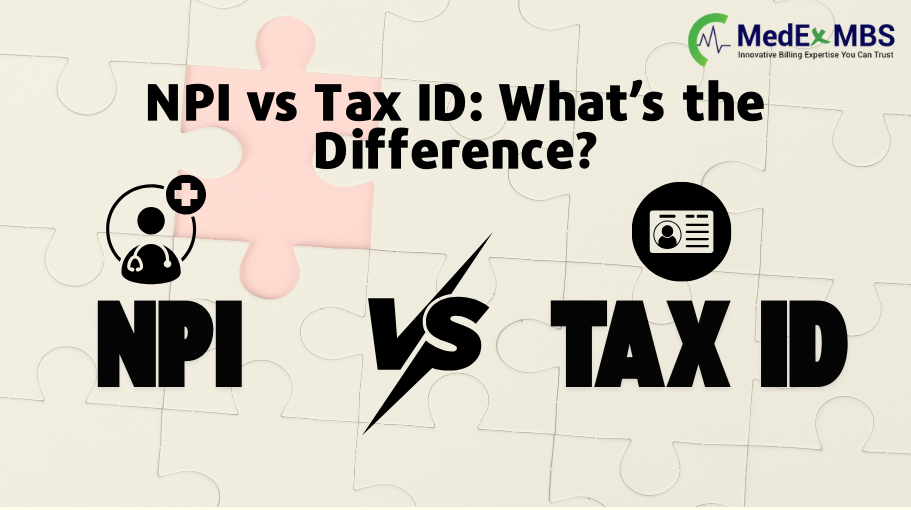
In the realm of medical billing, identifying providers is crucial for the accurate submission of claims and the proper reimbursement process. Among the key identifiers utilized in healthcare are the NPI (National Provider Identifier) and the Tax ID (TIN or EIN: Employer Identification Number). Although these identifiers are frequently referenced together, they fulfill distinctly different functions. If you are in the process of establishing a new practice, billing for claims, or engaged in healthcare administration, comprehending the operation of these two numbers and their combined usage can prevent you from experiencing expensive delays or claim denials. Let us clarify this further. What is an NPI Number? An NPI (National Provider Identifier) is a unique 10-digit identification number assigned to healthcare providers by the Centers for Medicare & Medicaid Services (CMS). It is a requirement for all entities covered by HIPAA, which includes: Physicians Dentists Nurses Clinics Hospitals Laboratories Pharmacies Why is it Necessary? The NPI serves to identify the individual who provided the healthcare service. It is utilized in claims, referrals, eligibility verifications, and other electronic transactions that adhere to HIPAA standards. What Are Type 1 and Type 2 NPIs? National Provider Identifiers (NPIs) are unique identification numbers employed within the U.S. healthcare system. They assist insurance companies and other providers in recognizing who delivered the care and the location of the service. NPIs are essential for billing and are utilized in all tasks related to HIPAA. There are two categories of NPIs: Type 1 NPI is designated for individual healthcare practitioners such as doctors, dentists, nurses, and therapists. Each individual is permitted to possess only one Type 1 NPI, regardless of their employment at multiple locations. Type 2 NPI is intended for healthcare entities, including hospitals, clinics, and group practices. These organizations may hold multiple Type 2 NPIs if they operate from various offices or have different business configurations. Both types of NPI are essential. For instance, when a patient visits a large clinic, the Type 2 NPI indicates which clinic was attended, while the Type 1 NPI identifies the specific provider who treated the patient. Example: Consider Dr. Emma Torres, a family physician at City Wellness Clinic. Torres’ Type 1 NPI: 1234567890 City Wellness Clinic’s Type 2 NPI: 1122334455 In a claim, the individual provider’s NPI (Dr. Torres) may be listed in the rendering provider field, while the clinic’s NPI is recorded in the billing provider field. Comparison Table: Type 1 vs. Type 2 NPI Feature Type 1 NPI (Individual) Type 2 NPI (Organization) Definition Assigned to individual healthcare providers Assigned to healthcare organizations or group entities Who Qualifies Physicians, dentists, nurses, physical therapists, pharmacists, BCBAs, RBTs, etc. Hospitals, physician groups, clinics, nursing homes, home health agencies, etc. Number Per Entity One NPI per individual, regardless of locations One or more NPIs, depending on the structure or practice locations Purpose Identifies the specific provider who delivers care Identifies the organization or facility where care is delivered Required For Individual billing, credentialing, claims, and prescriptions Facility-level billing and organizational claims processing HIPAA Compliance Mandatory for individual providers under HIPAA Mandatory for organizations handling HIPAA transactions Billing Example Used to specify who treated the patient in a group or hospital Used to specify where the patient was treated or which organization provided care Issued By Centers for Medicare & Medicaid Services (CMS) Centers for Medicare & Medicaid Services (CMS) Format 10-digit numeric code (same for both types) 10-digit numeric code (same for both types) Steps and Requirements to Obtain an NPI Healthcare professionals and organizations are required to obtain a National Provider Identifier (NPI) to engage in insurance credentialing and billing. This 10-digit number is used to uniquely identify providers in healthcare transactions. NPI numbers are classified into two categories: Type 1 is allocated to individual healthcare providers, whereas Type 2 is assigned to organizations and group practices. For Individual Providers: Applicants are required to submit personal information, which includes their full name, date of birth, and Social Security Number. Additionally, details regarding their practice, such as location, specialty, and any relevant licenses or certifications, must be provided during the application process. For Group Practices: An authorized representative is responsible for filling out the application on behalf of the organization. This individual is accountable for providing the group’s legal name, business address, Tax Identification Number (TIN), and their own contact details. Possessing an NPI is crucial for engaging with insurance payors. It is a prerequisite for credentialing and is necessary for the submission of claims. Without an NPI, providers and healthcare groups are unable to receive payments from insurance companies. NPIs enable insurers to accurately identify providers, verify claims, and ensure prompt reimbursements. What are the differences between a Group NPI and an Individual NPI? Healthcare providers who provide direct patient care are required to obtain an Individual NPI, which serves as a unique identifier that remains with them throughout their professional journey, irrespective of their workplace. Conversely, agencies are assigned a Group NPI based on their Tax ID. To facilitate proper credentialing and accurate billing, each provider’s Individual NPI must be linked to the Group NPI. This connection is vital to correctly associate the provider under the agency’s contracts with payors. Even if a provider possesses an Individual NPI and has a distinct agreement with an insurance company, they cannot be billed under the group unless they are officially affiliated with the group’s contract. Establishing this connection is a fundamental aspect of the credentialing process. How is This Connected to Rendering Providers? When claims are submitted, the billing and rendering NPIs are recorded in distinct sections of the CMS-1500 form. The rendering provider’s NPI, which is their Type 1 Individual NPI, should be placed in Box 24J. Box 33A should contain the billing provider’s NPI, which is generally the Type 2 Group NPI. The provider’s individual NPI must also be officially linked to the group’s NPI with each insurance payor. Without this linkage, claims may not be processed accurately, leading to potential payment delays. Even if a provider
What are the common cardiology billing challenges faced by providers, and how can they be addressed?
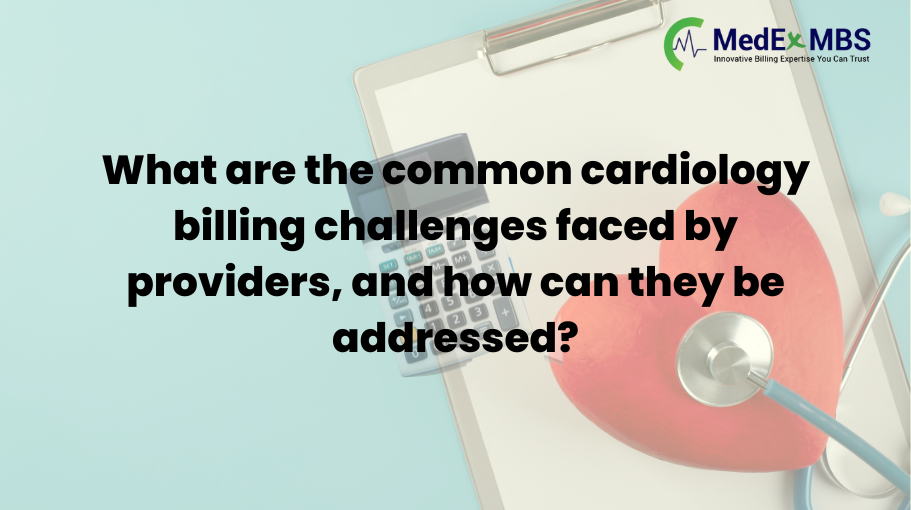
Introduction U.S. healthcare providers incur losses exceeding $125 billion annually due to billing inaccuracies. Cardiology practices specifically lose between 5% and 8% of their revenue due to claim denials, coding errors, and uncollected payments. These financial losses accumulate rapidly and can adversely affect the economic stability of any practice. The billing process in cardiology is intricate and labor-intensive, involving numerous procedures, evolving regulations, and stringent payer requirements. Minor errors frequently result in payment delays or claim rejections. Additionally, it offers straightforward and effective strategies to address these issues and safeguard your revenue. What Are the Challenges in Cardiology Medical Billing? The frequent updates in coding have rendered Cardiology Billing increasingly complicated. Stringent documentation requirements and escalating payer expectations imply that even minor mistakes can lead to lost revenue, denied claims, and compliance challenges. Below are the key challenges that cardiology practices currently encounter: Coding Complexity and Documentation Issues The bundling of procedures leads to confusion regarding cardiac catheterizations and PCI with stent placements. Tracking global periods for surgeries necessitates precise documentation of follow-up services. Proper application of modifiers (-26, -TC, -50, -RT, -LT, -59, -XS) is crucial to prevent claim denials. Each type of echocardiogram (2D, 3D, stress, contrast) requires the appropriate CPT code. Nuclear cardiology, cardiac MRI, and CT angiography demand accurate coding for various views and contrast usage. Electrophysiology studies and ablations must include comprehensive documentation to satisfy medical necessity criteria. The introduction of new ICD-10 codes for HFpEF necessitates clear documentation regarding the type of heart failure. Providers are required to differentiate between systolic and diastolic failure and indicate whether it is acute or chronic. Billing for CAD must document native vessels versus grafts, severity, and any complications. Documentation should provide evidence-based indications, a risk-benefit analysis, and alternative treatment options. Prior Authorization and Payer Management Advanced imaging techniques, such as MRI and nuclear studies, are subject to stringent approval regulations. Electrophysiology procedures and device implants frequently require multi-step approvals, which can delay patient care. The authorization process typically takes between 7 to 14 business days, hindering scheduling and cash flow. Emergency cases seldom receive retroactive approvals, and the success rate for appeals is low. The rules set by commercial payers differ by region and may incorporate conditions related to value-based care. Revenue Cycle Management Inefficiencies Elevated Denial Rates: 35% attributed to medical necessity 28% due to incorrect coding 22% for absent authorization 15% resulting from documentation deficiencies The clean claim rate is merely 78–82%, falling short of the 85–90% benchmark. Electronic Medical Records (EMR) and billing software frequently fail to synchronize, leading to missed charges. Eligibility checks and real-time updates often lack reliability. Staffing and Training Issues A shortage of certified coders and billers exacerbates errors. High employee turnover disrupts workflows and necessitates continuous retraining. Frequent Regulatory Changes Updates from CMS and revisions to ICD-10 require ongoing training efforts. Failure to remain up-to-date leads to denials or compliance audits. Front-End Intake Problems As many as 50% of denials originate from errors in patient demographics or insurance information. Missing referrals or incomplete eligibility verification can delay claims processing. Poor System Interoperability Electronic Health Records (EHR) and billing platforms often lack seamless integration. The absence of real-time data exchange hampers authorizations and claims processing. Manual Processes Manual workflows contribute to increased coding errors and slow processing times. Paper-based systems complicate scaling efforts and tracking of denials. Denials, Appeals, and Audit Risks The rates of denial in cardiology are 15–20% greater than those in primary care. Appeals can be expensive and often have a low success rate for documentation errors. The frequency of payer audits is increasing, which raises the compliance workload. Value-Based Care and Telehealth New quality-based care models necessitate detailed reporting and the use of different codes. Telehealth requires appropriate modifiers and adherence to payer-specific billing regulations. Patient Billing and Transparency Issues with balance billing lead to disputes and negatively affect patient trust. The absence of upfront cost estimates contributes to increased unpaid balances. Data Security and Compliance Achieving HIPAA compliance becomes more challenging with multiple digital systems in place. Incomplete documentation can lead to penalties and audits. How Do These Challenges Affect Providers? Billing issues in cardiology extend beyond administrative delays; they directly impact revenue. Denials, underpayments, and delayed payments all influence income. Revenue Loss Each denied or underpaid claim results in financial loss and consumes staff time. Numerous cardiology practices maintain overdue accounts for extended periods, which hampers cash flow and diminishes collections. Underpayments are particularly difficult to identify. If not monitored closely, they can go unnoticed. Over time, these minor losses accumulate and adversely affect the financial bottom line. AR Aging and Write-offs Most claims are expected to be settled within 30–45 days. However, many practices have claims that remain unpaid for over 90 days, significantly exceeding the industry average. The likelihood of payment decreases as claims age, with many ultimately being written off. Frequent write-offs indicate underlying issues, such as coding errors or inadequate follow-up. Additionally, older claims are more costly to recover, as time lost translates to money lost. Cost of Denials Challenging a rejected claim can incur significant expenses, varying from $25 to $118 for every claim. This expense encompasses staff time, administrative work, and follow-up efforts. Moreover, not all appeals are successful. When a denial is related to documentation or medical necessity, the chances of approval diminish significantly. Consequently, your team may invest considerable hours on appeals that do not yield payment. How to Address Cardiology Billing Issues Minor adjustments are insufficient to tackle the challenges associated with cardiology billing. It is essential to utilize intelligent tools, established processes, and expert assistance. Companies specializing in cardiology medical billing can aid practices in navigating these challenges and recovering lost revenue. Below are the solutions you should consider. Technological Solutions for Cardiology Billing Contemporary billing processes rely heavily on automation and data analytics. Utilizing the appropriate tools can help
How Long Does Credentialing Take?
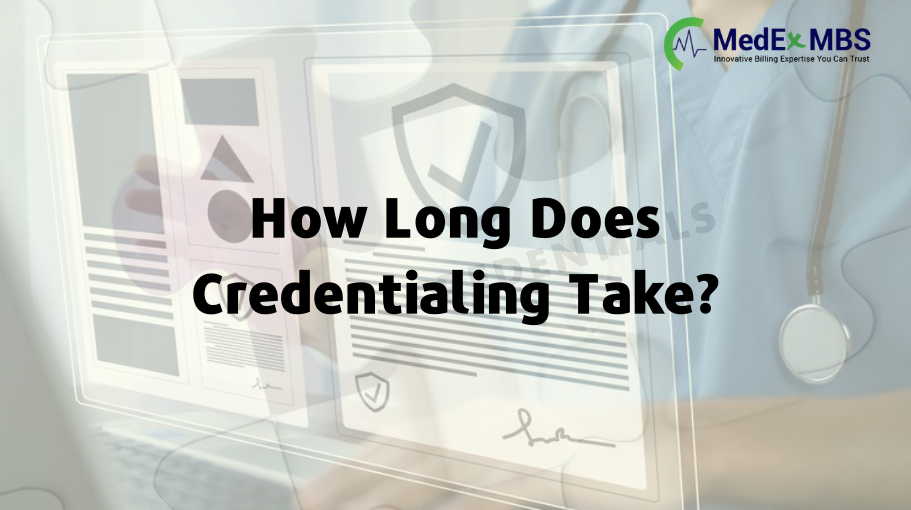
If you operate a healthcare practice, you are likely well-acquainted with the various components of the healthcare system and its processes. Some of these components occur rapidly, while others may take longer to develop. Credentialing represents a vital and important phase in the onboarding procedure for healthcare professionals. This process is also referred to as provider credentialing, medical credentialing, and physician credentialing. It entails a thorough verification of healthcare providers to confirm that they fulfill the necessary criteria for delivering quality services. However, it is important to note that this process can be quite time-consuming and may require more time than healthcare providers typically anticipate. If you are interested in understanding the duration of the credentialing process and the primary factors that may cause delays in provider credentialing, we encourage you to read this article. Additionally, you will discover effective strategies to enhance the efficiency of the credentialing process. Let us begin! What is the typical duration required to credential a provider? Physician credentialing provides numerous advantages for both patients and healthcare providers. This process ensures that all professional credentials are accurately verified, allowing patients to receive high-quality care. Credentialing specialists are also capable of identifying fraudulent credentials, thereby preserving the integrity of a healthcare practice. Furthermore, a more expedited credentialing process enables patients to access the quality care they desire without unnecessary delays. Ultimately, this efficiency allows healthcare providers to receive their reimbursements promptly. Typically, the entire procedure can take several weeks to months to finalize the credentials for healthcare providers. Typically, the duration for provider credentials averages between 90 and 120 days. However, it is important to note that this is merely an average estimate. The precise duration of a provider’s credential is contingent upon several factors, including: The efficiency of the organization’s credentialing process The accuracy and effectiveness of provider documentation The complexity of the provider’s background The method of credential Generally, the anticipated approval times for credentials are as follows: Credentialing for Medicare and Medicaid: 60 to 90 days NPI application: 30 minutes Initial versus re-credentialing times: 90 to 150 days / 45 to 90 days Commercial insurance carrier credentialing: 60 to 90 days (30 days for contracting) Online CAQH application: 3 hours The provider credentialing process should ideally be expedited. If healthcare providers are solely focused on credentials, they may neglect their patients. This can adversely affect the revenue stream of a healthcare organization. If healthcare providers do not meet the credentialing requirements for approval, they will be unable to offer their services. Consequently, the healthcare organization will miss out on the benefits of its professional expertise. Therefore, the medical credentialing process must be efficient and effective, enabling healthcare providers to reach their objectives. What documents are necessary for Credentialing? The initial phase of credentialing healthcare providers entails the verification of all documents submitted by these providers. Credentials specialists are tasked with this responsibility and meticulously review each document. They also conduct primary source verification to ensure accurate assessment. During this initial phase, the following documents are verified as they are crucial for the credentials process. Application The initial application serves as a form that collects all pertinent information, including personal details such as contact information and other background specifics. The processing time for credentialing applications can vary. Education Providers must submit documentation of their educational qualifications, including certificates, diplomas, and similar credentials. Personal identification This category includes the passport, driver’s license, and social security number. Professional documents This encompasses board certificates, medical licenses, and associated registrations, among others. Previous work history Providers are also required to furnish details regarding their past responsibilities, including affiliations with professional organizations, employment dates, and job descriptions. Malpractice insurance Alongside the documents, providers are required to submit proof of malpractice insurance coverage. DEA registration If healthcare providers prescribe controlled substances, they must submit their registration details to the Drug Enforcement Administration (DEA). Criminal record Credential professionals also investigate whether there is any criminal record associated with a provider to avert potential issues in the future. What are the primary steps involved in the credentialing of providers? The primary steps in the credential process are outlined as follows: Information Gathering The initial step entails the collection of the necessary credentials for credential. Comprehensive information regarding healthcare providers is compiled. Additionally, other pertinent details include the physical address, mailing address, individual or group National Provider Identifier (NPI), clinic fax number, Tax Identification Number, Master Provider Index, and so forth. The duration of this step can vary, but it typically spans a few weeks. Creation of a Payer List The subsequent step involves formulating a list of payers and insurance networks with which you intend to contract or participate in their insurance plans. The choice of insurance networks is determined by the preferences and requirements of the healthcare practice. Government Health Plans This includes TRICARE, Medicaid, Medicare, the Children’s Health Insurance Program (CHIP), and VA Health Care. Health Insurance Right Health United Healthcare Cigna Humana Anthem Kaiser Permanente Blue Cross Blue Shield Bright Health Aetna Oscar Health Sidecar Health Lemonade Development of CAQH Profile The CAQH (Council for Affordable Quality Healthcare) is a database that authenticates provider information. Initially, a CAQH profile is established and subsequently maintained. Creating a CAQH profile is highly advantageous as it enables one to apply for credentials at multiple organizations simultaneously. State credentialing application Some credential applications are specific to states and gather information related to education, training, experience, and licensure. Determining the payer’s credentialing requirements The initial step you should undertake before commencing your application process is to ascertain how many payers you wish to collaborate with. Additionally, you should identify the requirements of each payer. By accessing their official website, you can ascertain all specific requirements. Subsequently, you can submit your application accurately. Submission of application Once you have compiled a list of payers and identified their requirements,
Complete OB-GYN Billing and Coding Guide to Streamline Your Practice’s Revenue Cycle
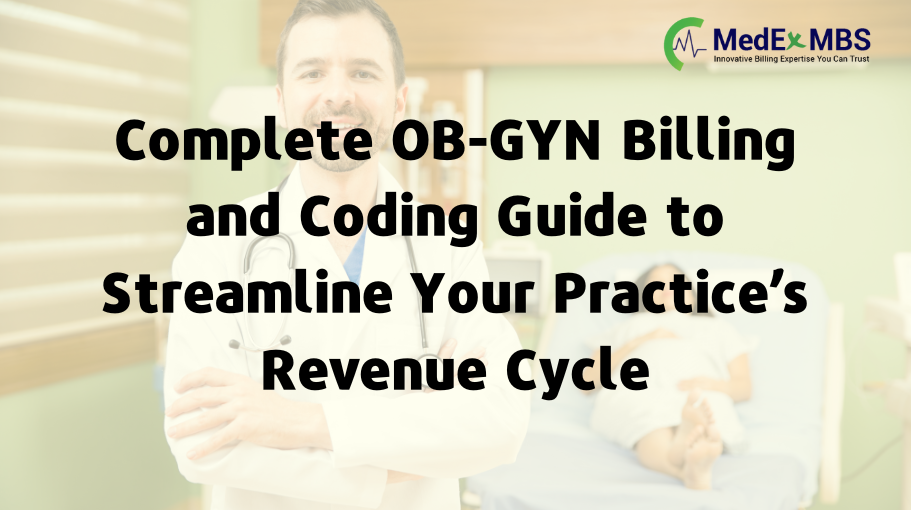
Best Practices in Gynecology Coding In the realm of gynecology coding, it is imperative to uphold high standards to ensure accurate billing and comprehensive patient care. By diligently documenting procedures and selecting the correct CPT codes according to the surgical approach and complexity, practices can guarantee an accurate representation of the services provided. This methodology not only facilitates efficient reimbursement processes but also maintains compliance with regulatory standards, ultimately improving the overall operational effectiveness of the gynecological practice. Procedure Type CPT Code Range Abdominal hysterectomy 58150-58210 Vaginal hysterectomy 58260-58291 Laparoscopic hysterectomy 58541-58573 By implementing these stringent standards, gynecologists can accurately capture the intricacies of each procedure, which contributes to enhanced financial health and patient outcomes within their practice. What Are CPT Codes and How They Relate to Gynecology? CPT (Current Procedural Terminology) codes are standardized codes utilized to denote medical, surgical, and diagnostic services. Created by the American Medical Association (AMA), these codes promote uniformity and precision in documenting and billing healthcare services across diverse medical practices. Role of CPT Codes in Gynecology In gynecology, CPT codes offer precise documentation for a wide range of procedures and services. Codes ranging from 56405 to 58999 encompass everything from minor diagnostic tests to significant surgical operations. These codes ensure that providers receive suitable reimbursement and maintain precise patient records. The proper application of gynecology CPT codes bolsters the financial stability of medical practices. This, in turn, improves the quality of care by guaranteeing that all services are documented and billed accurately. Understanding and utilizing these codes is crucial for effective healthcare delivery. How do CPT Codes Classify Gynecology into Specific Categories? Gynecology CPT codes classify the specialty into specific categories for billing and documentation purposes. These codes organize various medical services associated with women’s reproductive health, ensuring accurate reimbursement and proper record-keeping. Evaluation and Management (E/M) Codes Imaging / Radiology Codes Surgical Procedure Codes Laboratory and Pathology Codes Pharmaceutical Codes The precise application of these categories in gynecology CPT codes guarantees thorough documentation, accurate billing, and effective management of a wide range of healthcare services pertaining to women’s reproductive health. 1. Evaluation and Management (E/M) Codes E/M codes classify office visits and wellness evaluations in gynecology. These codes ensure that healthcare providers bill appropriately for the level of service rendered, considering the complexity of patient history, medical decision-making, and preventive counseling. Accurate documentation is crucial to support the correct application of E/M codes and ensure adherence to billing regulations, thus facilitating comprehensive healthcare management for women’s reproductive health. 99202-99215 Office visits range from problem-focused to comprehensive evaluations. 99384-99387 Annual wellness visits for new patients aimed at preventive management. 99394-99397 Annual wellness visits for established patients focused on preventive management. 99401-99404 Counseling codes for preventive services such as contraceptive counseling. 81025 Detects human chorionic gonadotropin (hCG) in urine to confirm early pregnancy status. 88164-88167 Codes for cervical cancer screening procedures like Pap smears. Evaluation and Management (E/M) codes are essential for billing gynecological services, which include everything from routine office visits to extensive preventive care. Healthcare providers employ these codes to accurately bill and document the level of service rendered, ensuring adherence to healthcare billing regulations and promoting optimal patient care in women’s reproductive health. 2. Imaging / Radiology Codes Radiology codes related to gynecology cover a range of imaging studies designed for specific conditions and anatomical areas. These codes are vital for diagnosing and managing various gynecological issues, ensuring accurate treatment planning and patient care. CPT Code Description 72193 Computed Tomography (CT) Pelvis: This code provides detailed scans of the pelvic area, which are crucial for diagnosing conditions such as uterine fibroids. 72195 Magnetic Resonance Imaging (MRI) Pelvis: This imaging technique uses magnetic fields to examine pelvic organs, assisting in the identification of conditions like ovarian cancer. 76830 Transvaginal Ultrasound: This procedure delivers detailed images of the uterus, cervix, and ovaries, which are essential for diagnosing issues such as endometrial abnormalities. 74740 Hysterosalpingography: This involves X-rays with contrast dye to evaluate the uterine cavity and fallopian tubes, which is beneficial in infertility assessments. 4. Laboratory and Pathology Codes Laboratory and pathology codes in gynecology encompass a variety of tests and procedures that are essential for diagnosing and monitoring women’s health conditions. These codes guarantee accurate reporting and billing for numerous diagnostic tests and pathology studies specifically designed for gynecological care. Diagnostic Tests CPT Code Description 76856 Pelvic ultrasound: This test employs sound waves to examine the pelvic region, including the uterus and ovaries, to detect any abnormalities. 58555 / 58558 Hysteroscopy: This procedure uses a slender, illuminated tube to inspect the uterus for issues such as fibroids or polyps. STI Testing Testing for Chlamydia and Gonorrhea (87491, 87591, 87850, and 87800): These examinations are conducted to identify sexually transmitted infections, which are crucial for prompt detection and treatment. Screening Procedures CPT Code Description 88141 / 88142 / 88143 Pap smear: This test analyzes cervical or vaginal smears to identify abnormal cells, aiding in the early detection of cervical cancer. 87624 / 87625 HPV testing: This test detects human papillomavirus infections, which are important for assessing the risk of cervical cancer and guiding treatment decisions. Biopsy Procedures Endometrial biopsy (58100, 58110, and 58120): This procedure involves the collection of tissue samples from the uterine lining to diagnose various conditions, including abnormal bleeding and endometrial cancer. These codes are essential in healthcare management as they enable precise diagnosis, treatment planning, and the development of disease prevention strategies that are specific to women’s reproductive health. 5. Pharmaceutical Codes Pharmaceutical codes related to gynecology include medications and treatments that are vital for managing health conditions affecting women. These codes guarantee accurate billing and documentation for a range of pharmaceutical interventions designed to meet the needs of gynecological care. Procedures and Interventions CPT Code Description 58555 Hysteroscopy,
